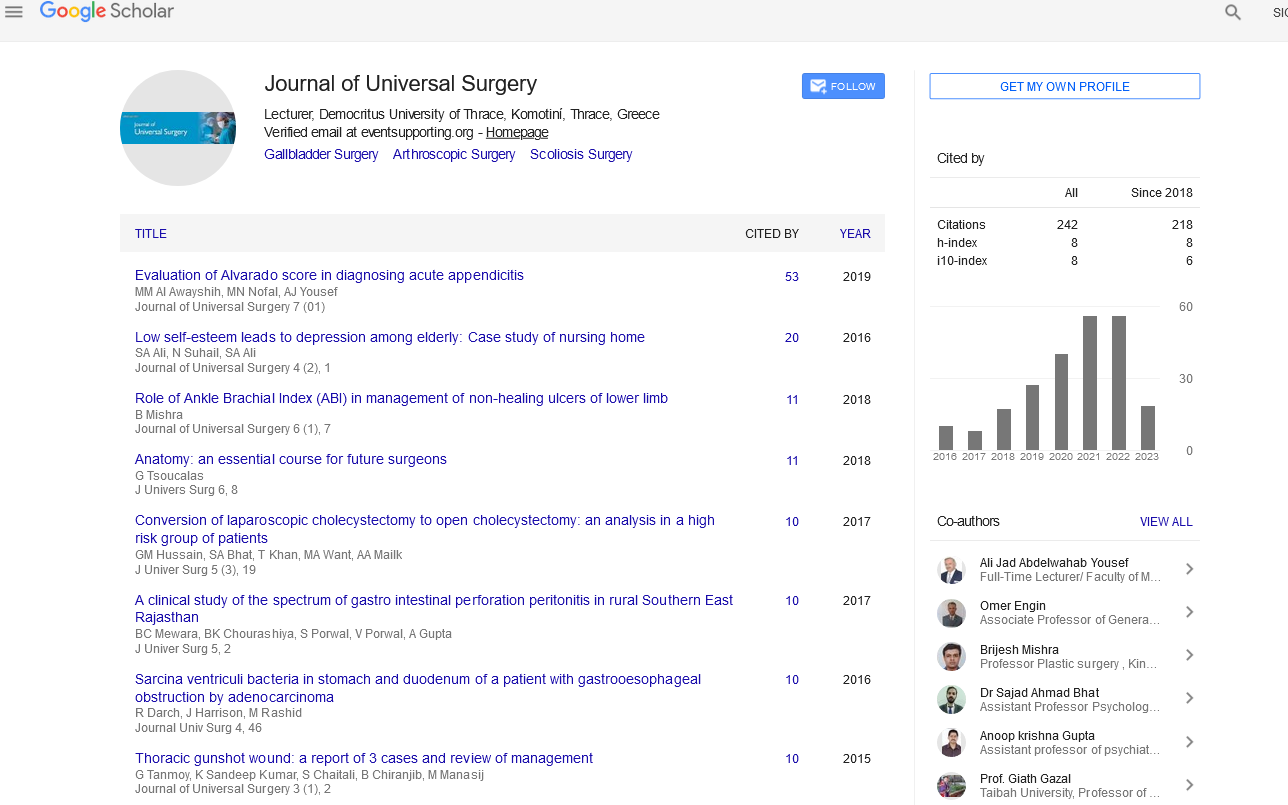Perspective - (2024) Volume 12, Issue 3
Thyroid Surgery by Robotics
Deacon Jhonathan*
Department of General Surgeon, Unversity of Lytton, Lytton, Canada
*Correspondence:
Deacon Jhonathan, Department of General Surgeon, Unversity of Lytton, Lytton,
Canada,
Email:
Received: 15-May-2024, Manuscript No. IPJUS-24-14848;
Editor assigned: 20-May-2024, Pre QC No. IPJUS-24-14848 (PQ);
Reviewed: 03-Jun-2024, QC No. IPJUS-24-14848;
Revised: 24-Jun-2024, Manuscript No. IPJUS-24-14848 (R);
Published:
27-Jun-2024
Introduction
In Western practice, robotic transaxillary thyroidectomy is still
a contentious procedure, despite being well-established in the
Far East. Adoption has been negatively impacted by the larger
body habits of Western patients, which compound the technical
difficulties of the process and raise issues of cost, training, and
ethics. Currently, the procedure is limited to use in individuals
who have a history of hypertrophic and keloid scarring together
with appropriate pathology, or in health care systems where
personalized treatment is utilized. Following an early surge in
interest, the number of robotic treatments in the Western World
has now plateaued and decreased. Remarkably, the biggest
numbers are carried out in low-volume hospitals, supporting
personalized treatment as the main force behind this.
Description
Young women are most likely to develop thyroid nodules,
including low-risk papillary thyroid carcinoma. This particular
patient group is, understandably, the one that is most concerned
about cosmesis. This is especially true in the Far East, where it is
thought that a horizontal scar on the neck signifies death.
The development of "scarless" endoscopic thyroidectomies (in
the neck) was prompted by the aforementioned issues. Over the
years, numerous approaches have been reported, such as
postauricular and axillary endoscopic approaches, bilateral
axilla-breast endoscopic approaches, axilla-bilateral-breast,
infraclavicular, breast, and axillary endoscopic approaches. But
out of all the endoscopic techniques tested, none turned out to
be better than the others. They were all characterized by the
same limitations of endoscopic surgery, which include the need
for insufflation, fulcrum effect, limitations in instrument
movement, and dependence on multiple assistants.
Robotic technology was developed to overcome the
limitations associated with endoscopic surgery. Its unique
features, such as a dual-channel stereoscopic endoscope that
offers simultaneous image magnification and depth perception
through 3-dimensional visualisation, along with its wristed
robotic instruments with seven degrees of freedom, significantly
improve surgical dexterity.
South Korea reported the first major series (n=100) of
transaxillary gasless robotic thyroidectomy in 2009. Thousands of instances were carried out in the Far East during the ensuing
years, as the treatment quickly gained popularity among the
local populace. In contrast, the Western World has seen a far
smaller uptake. There have been several causes linked to this,
such as cultural differences, anthropometric inequalities,
compensation concerns, and the existence.
A nationwide thyroid cancer screening program in South
Korea that has made thyroid nodules easier to remove by
detecting them early, frequently when they are less than 1
centimeter in diameter Level 2a evidence supports robotic
thyroidectomy as a safe, viable procedure that is better
cosmetically than open surgery in terms of cosmesis and
feasibility. The majority of studies on the viability and safety of
robotic thyroidectomy come from the Far East, although there
are also studies from high-volume centers in the UK, Europe,
and North America.
Operation is better than traditional open surgery (level 2b)
Recurrent laryngeal nerve damage, hypoparathyroidism, and
hemorrhage have been found to be the most prevalent
problems following thyroid surgery, according to five metaanalyses
of cohort studies that combined pooled data from
several thousand patients. There were no discernible differences
(level 2a) between robotic and open thyroidectomy with regard
to hemorrhage, permanent hypoparathyroidism, or temporary
and permanent recurrent laryngeal nerve injury. Patients
undergoing robotic thyroidectomy (level 2a) had a greater inci
dence of transitory hypoparathyroidism.
Reviews from 2016 expanded this analysis to include data
from more than 15 studies, supporting the finding that there
was no difference in length of hospital stay, quality of life,
wound infection, seroma, chyle leak, and tracheal damage
between robotic and traditional thyroidectomy.
However, early swallowing and scar satisfaction consistently
demonstrated a significant improvement in favor of the robotic
technique (level 2a). Not every patient, surgeon, or facility is a
good fit for robotic thyroidectomy at this time. Selecting
patients with care and moderation is crucial. In addition to
taking ethics into account, scientific research and methodical,
thorough review should always be used when implementing any
new surgical technology. Innovation adoption should be guided
by evidence, and commercial enterprises should financially
support future ethically authorized research.
These kinds of studies will offer the kind of governance and
direction needed for the safe and efficient implementation
of novel surgical technologies.
Conclusion
When patients are carefully chosen, there is evidence to
support robotic transaxillary thyroidectomy for the treatment of
both benign and malignant illness. High-volume surgeons
working in specialized centers as a multidisciplinary robotic team
should do this treatment. Centralization will support and encourage additional research, offer a platform for instruction
and teaching, and provide the framework for ensuring patient
safety through audit and governance. Although new robotic
techniques for thyroidectomy that use the retroauricular and
transoral routes have been reported, more research is needed
to determine each technique's place in contemporary thyroid
surgery.
Citation: Jhonathan D (2024) Thyroid Surgery by Robotics. J Univ Surg Vol.12 No.3: 021.





